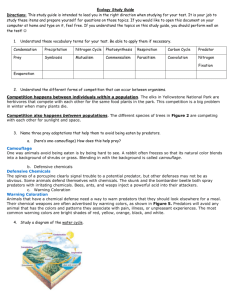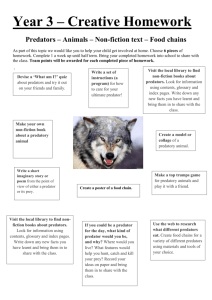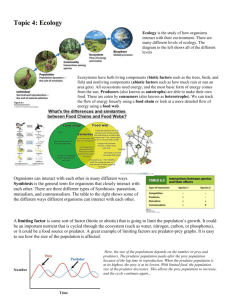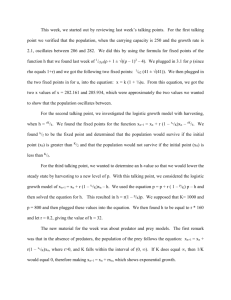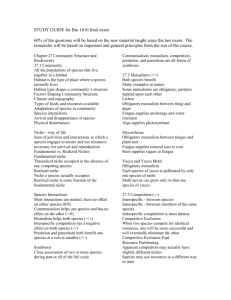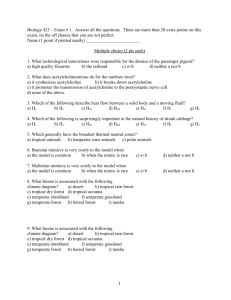Study Guide: Ecology
advertisement
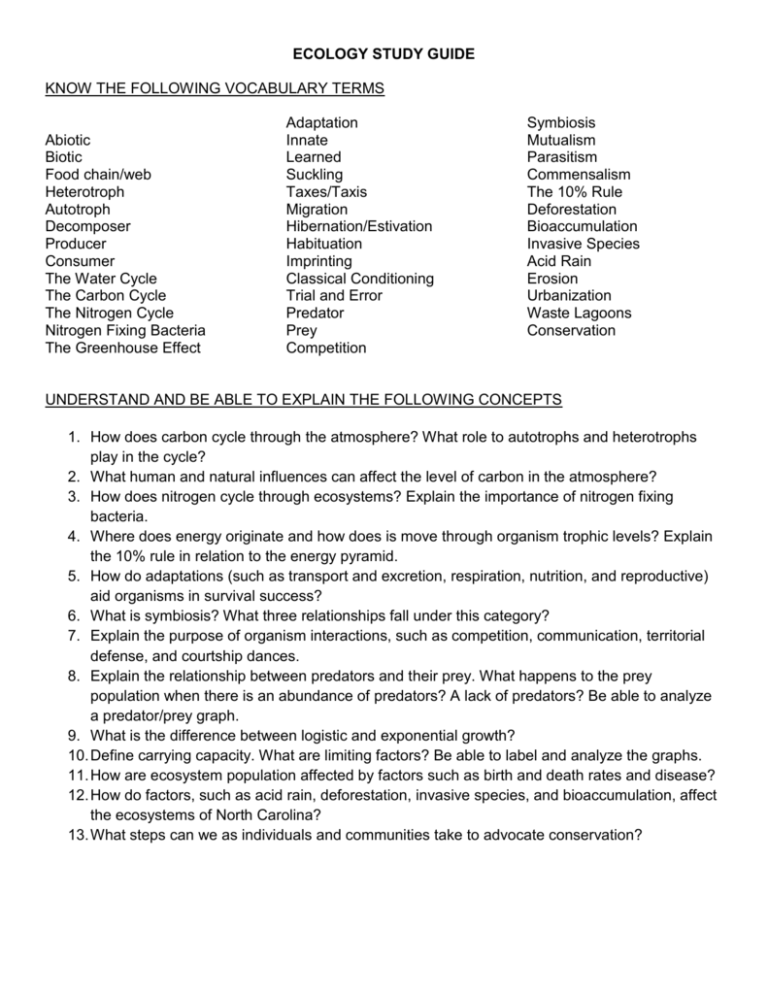
ECOLOGY STUDY GUIDE KNOW THE FOLLOWING VOCABULARY TERMS Abiotic Biotic Food chain/web Heterotroph Autotroph Decomposer Producer Consumer The Water Cycle The Carbon Cycle The Nitrogen Cycle Nitrogen Fixing Bacteria The Greenhouse Effect Adaptation Innate Learned Suckling Taxes/Taxis Migration Hibernation/Estivation Habituation Imprinting Classical Conditioning Trial and Error Predator Prey Competition Symbiosis Mutualism Parasitism Commensalism The 10% Rule Deforestation Bioaccumulation Invasive Species Acid Rain Erosion Urbanization Waste Lagoons Conservation UNDERSTAND AND BE ABLE TO EXPLAIN THE FOLLOWING CONCEPTS 1. How does carbon cycle through the atmosphere? What role to autotrophs and heterotrophs play in the cycle? 2. What human and natural influences can affect the level of carbon in the atmosphere? 3. How does nitrogen cycle through ecosystems? Explain the importance of nitrogen fixing bacteria. 4. Where does energy originate and how does is move through organism trophic levels? Explain the 10% rule in relation to the energy pyramid. 5. How do adaptations (such as transport and excretion, respiration, nutrition, and reproductive) aid organisms in survival success? 6. What is symbiosis? What three relationships fall under this category? 7. Explain the purpose of organism interactions, such as competition, communication, territorial defense, and courtship dances. 8. Explain the relationship between predators and their prey. What happens to the prey population when there is an abundance of predators? A lack of predators? Be able to analyze a predator/prey graph. 9. What is the difference between logistic and exponential growth? 10. Define carrying capacity. What are limiting factors? Be able to label and analyze the graphs. 11. How are ecosystem population affected by factors such as birth and death rates and disease? 12. How do factors, such as acid rain, deforestation, invasive species, and bioaccumulation, affect the ecosystems of North Carolina? 13. What steps can we as individuals and communities take to advocate conservation? ECOLOGY STUDY GUIDE KNOW THE FOLLOWING VOCABULARY TERMS Abiotic Biotic Food chain/web Heterotroph Autotroph Decomposer Producer Consumer The Water Cycle The Carbon Cycle The Nitrogen Cycle Nitrogen Fixing Bacteria The Greenhouse Effect Adaptation Innate Learned Suckling Taxes/Taxis Migration Hibernation/Estivation Habituation Imprinting Classical Conditioning Trial and Error Predator Prey Competition Symbiosis Mutualism Parasitism Commensalism The 10% Rule Deforestation Bioaccumulation Invasive Species Acid Rain Erosion Urbanization Waste Lagoons Conservation UNDERSTAND AND BE ABLE TO EXPLAIN THE FOLLOWING CONCEPTS 1. How does carbon cycle through the atmosphere? What role to autotrophs and heterotrophs play in the cycle? 2. What human and natural influences can affect the level of carbon in the atmosphere? 3. How does nitrogen cycle through ecosystems? Explain the importance of nitrogen fixing bacteria. 4. Where does energy originate and how does is move through organism trophic levels? Explain the 10% rule in relation to the energy pyramid. 5. How do adaptations (such as transport and excretion, respiration, nutrition, and reproductive) aid organisms in survival success? 6. What is symbiosis? What three relationships fall under this category? 7. Explain the purpose of organism interactions, such as competition, communication, territorial defense, and courtship dances. 8. Explain the relationship between predators and their prey. What happens to the prey population when there is an abundance of predators? A lack of predators? Be able to analyze a predator/prey graph. 9. What is the difference between logistic and exponential growth? 10. Define carrying capacity. What are limiting factors? Be able to label and analyze the graphs. 11. How are ecosystem population affected by factors such as birth and death rates and disease? 12. How do factors, such as acid rain, deforestation, invasive species, and bioaccumulation, affect the ecosystems of North Carolina? 13. What steps can we as individuals and communities take to advocate conservation?


